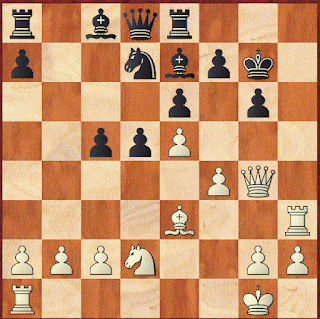The interesting point, apart from the game itself, is that Stavsky, White, is identified as the "Palestinian Champion". Usually the first Palestinian championship is given as having taken place in 1936 (won by Czerniak; see here for Hebrew-language link.) However, it is sometimes said that there was an earlier, 1929 such tournament took place. If so, it is possible that Stavsky had won it.
As for the game itself: could it be from that championship? Doar Hayom merely notes, unfortunately, that Stavsky sent them the game. No venue is suggested. However, it just might be one of the games played in that championship -- due to the very fact that it was recorded, a rare event in the 1920s in Palestine. If so, then 50 years after an effort was made to find game scores from the tournament without success (as the link above about the 1929 tournament notes), this might, just possibly, the first game of the championship to ever emerge.
Edited to add: a reader notes that Doar Hayom reported Stavsky as participating in the Tel Aviv city championship of 1928 (link in Hebrew) on Oct. 16th, 1928. It seems, based on the dates, that this is the championship in question, and not any "Palestine Championship". Ah well!
The annotations are credited, with thanks, to Shahar Gindi.
Event:
White: Stavsky
Black: Gildberg
ECO: B44
Annotator: Shahar Gindi
1. e4 c5 2. Nf3 e6 3. d4 cxd4 4. Nxd4 Nf6 5.Bd3 Not the most popular move, but definitely playable. 5... Nc6 6. Be3 6. Nxc6 is most often played. 6... d5! = 7. Nxc6 bxc6 8. e5 Nd7 9. f4 Be7 Passive. A nice option for Black here is 9...Ba6! using tactics to get rid of his own bad bishop and White's best attacking piece: 9... Ba6! 10. Bxa6 Qa5+ 11. Nd2 Qxa6 =.
10. O-O O-O 11. Nd2 Re8 Passive, but still playable.12. Bxh7+? Too speculative. 12. Qh5 g6 13. Qg4; or 12. Rf3 c5 13. Bxh7+ Kxh7 14. Rh3+ Kg8 15. Qh5 f5 and White at least has a draw. 12... Kxh7 13. Qh5+ Kg8 14. Rf3 g6 15. Qg4 Kg7 16. Rh3 c5 Stavsky gives this move a "?", and indeed it is more to the point to play a defensive move, but it's far from losing. However, 16... Rh8! leaves White with very little for the sacrificed material.
17. f5 exf5 18. Bh6+ Kg8 19. Qf4 Bb7 20. Nf3 20. Bg7 doesn't work: 20. ... Bg5! -+ (20... Kxg7?? 21. Qh6+ Kg8 22. Qh8#). 20... f6?
Now White plays brilliantly to the end. 20... Nf8, bringing another piece to the defense, saves the game for Black: 21. Bg5 f6 22. exf6 Bxf6 -+. 21. Rg3! Kf7 22. e6+! Kxe6 23. Re1+! Kf7 24. Qxf5!! gxf5 25. Rg7+ Kf8 26. Nh4
Now mate is inevitable. 26. ... Ne5 27. Rxe5 fxe5 28. Ng6# 1-0. The final position deserves a diagram:




No comments:
Post a Comment